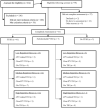A Multi-Method Approach to a Comprehensive Examination of the Psychiatric and Neurological Consequences of Intimate Partner Violence in Women: A Methodology Protocol
- PMID: 33679466
- PMCID: PMC7933589
- DOI: 10.3389/fpsyt.2021.569335
A Multi-Method Approach to a Comprehensive Examination of the Psychiatric and Neurological Consequences of Intimate Partner Violence in Women: A Methodology Protocol
Abstract
The number of women in the United States that experience blows to the head during assaults by intimate partners is substantial. The number of head blows that result in a traumatic brain injury (TBI) is virtually unknown, but estimates far exceed numbers of TBI in parallel populations (e.g., blast exposure, accidents, sports) combined. Research on the impact of TBI on post-traumatic stress disorder (PTSD) in survivors of intimate partner violence (IPV) is sparse. This methodology paper describes the comprehensive, multi-method approach used by a multi-disciplinary team of investigators from several different fields of expertise to assess the interaction of psychiatric, cognitive, psychological, and physical conditions that result from IPV. Using state-of-the-art instruments, a comprehensive assessment of lifetime trauma exposure, lifetime history of TBI, psychiatric history, and a full assessment of current cognitive, neuropsychological and biomedical function was conducted with 51 female survivors of IPV who screened positive for PTSD. This multi-method assessment included clinician-administered diagnostic interviews modified to specifically assess the sequelae of IPV, standardized self-report surveys, neuropsychological tests, structural, diffusion, and functional neuroimaging and blood-based biomarkers. The specific details and full report of the results of the full study are beyond the scope of this methodology paper. Descriptive characteristics of the complex clinical presentation observed in this unique sample are described. The sample reported high rates of trauma exposure across the lifespan and 80% met full criteria for current PTSD. Women also reported high rates of lifetime subconcussive head injury (88.2%) and TBI (52.9%) from various etiologies (35.3% secondary to IPV). Descriptive findings from the methodological protocol described here have begun to reveal information that will advance our understanding of the impact of subconcussive head injury and TBI on recovery from mental injury among IPV survivors.
Keywords: concussion; intimate partner violence; post-traumatic stress; traumatic brain injury; women.
Copyright © 2021 Galovski, Werner, Iverson, Kaplan, Fortier, Fonda, Currao, Salat and McGlinchey.
Conflict of interest statement
The authors declare that the research was conducted in the absence of any commercial or financial relationships that could be construed as a potential conflict of interest.
Figures


References
-
- Niolon PHM, Kearns J, Dills K, Rambo S, Irving T, Armstead L, et al. . Preventing Intimate Partner Violence Across the Lifespan: A Technical Package of Programs, Policies, and Practices. Atlanta, GA: National Center for Injury Prevention and Control, Centers for Disease Control and Prevention; (2017).
-
- Breiding MK, Basile CSG, Smith MC, Black, Mahendra RR. Intimate Partner Violence Surveillance: Uniform Definitions and Recommended Data Elements. Version 2.0. National Center for Injury Prevention and Control of the Centers for Disease Control and Prevention (2015).
-
- Smith SGJ, Chen KC, Basile LK, Gilbert MT, Merrick N, et al. . The National Intimate Partner and Sexual Violence Survey (NISVS): 2010-2012 State Report. Atlanta, GA: National Center for Injury Prevention and Control, Centers for Disease Control and Prevention; (2017).
-
- Caldwell JE, Swan SC, Woodbrown VD. Gender differences in intimate partner violence outcomes. Psychol Violence. (2012) 2:42. 10.1037/a0026296 - DOI
Grants and funding
LinkOut - more resources
Full Text Sources
Other Literature Sources
Research Materials
Miscellaneous

